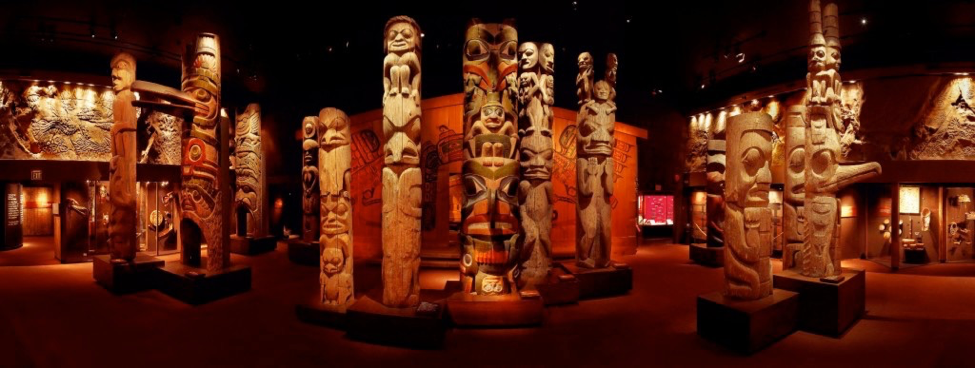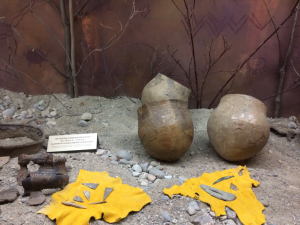18 Indigenous Artifacts
Gallery and Museum Critique

Museums and art galleries fill a number of roles in society. They are institutions designed for entertainment and exploration. They are also powerful sources of education for the general public and valued repositories of cultural and natural knowledge. As research facilities, they are primarily in the business of acquiring, holding, displaying, and categorizing cultural and material items. Despite this compelling and highly regarded role, museums and art galleries have a contested past.
Museums and galleries across Canada have a long history of challenging relations with First Peoples. As public facilities, they strive to display and share knowledge and stories from a variety of cultures, including Indigenous material culture and Indigenous art. However, the display and dissemination of knowledge related to First Peoples are often not conducted with the support and input of Indigenous communities. Instead, too often non-Indigenous curators, collectors, and researchers decide what goes on display and how it should be presented. Before the 1980s it was not uncommon for exhibits to romanticize, simplify, and ultimately offend Indigenous Peoples and fail to represent the complexity of their cultures.
Racist Displays and the Demand for Consultation
Gallery 4.4 Museums and galleries’ contested past
This problematic relationship and mismanagement of historical narratives began with the work of anthropologists, biologists, and natural scientists over 150 years ago. These specialists amassed vast collections of minerals, plants, animals, and Indigenous cultural items with the intent of studying, comparing, displaying, and storing them. These collections were often used to promote a cultural hierarchy that erroneously placed Europeans and their descendants at the pinnacle of cultural achievement. First housed in curiosity cabinets, they would later be the basis for the creation of museums and galleries, which served to strengthen and reinforce Western domination over non-Western cultures (Ashley, 2005; Ferris, 2003; Thornhill, 2011).
From the 1840s through to the 1940s, North America experienced a significant upsurge in museum and gallery building (Phillips, 2006; Thornhill, 2011). Many collections amassed for curiosity cabinets found their way into museums. Natural history museums regularly used their growing collections to mount racist displays of Indigenous Peoples.
The early 1980s saw Canadian Indigenous communities placing public pressure on museums and art galleries to consult with First Peoples on exhibits regarding their culture and history. After public protests against The Spirit Sings exhibit in 1988 and the Into the Heart of Africa exhibit in 1989, Canadian museums and art galleries were forced to examine their relationships with and representations of First Peoples (Martin, 2012; Task Force on Museums and First Peoples [TFRMFP], 1994).
Archaeology

Archaeologists have also contributed to First Peoples’ distrust of museums and art galleries. First Peoples traditionally believe that their ancestors’ remains and spiritual items should remain in the earth to decay as a part of the natural order (Curve Lake First Nation, n.d.; Nicholas & Andrews, 1997). Early archaeological excavations for purposes of development or university research often disregarded the sensitive and sacred nature of Indigenous burial practice, excavating cultural material, human remains, and spiritual items against the wishes of Indigenous communities. Excavated objects were typically placed into storage for research or put on display in museums. Before the 1990s First Peoples were rarely consulted by the archaeologists who undertook these excavations. This went against the spiritual and cultural beliefs of First Peoples and reinforced their concerns regarding a lack of respect for Indigenous values by non-Indigenous people (Curve Lake First Nation, n.d.). Today, many Indigenous communities act as caretakers of their cultural history, protecting historical sites from disturbance to ensure the spiritual and cultural protection of their ancestors.
Canadian Archaeological Association Statement of Principles for Ethical Conduct Pertaining to Aboriginal Peoples
Consultation:
- To recognize the cultural and spiritual links between Aboriginal peoples and the archaeological record.
- To acknowledge that Aboriginal people have a fundamental interest in the protection and management of the archaeological record, its interpretation and presentation.
- To recognize and respect the role of Aboriginal communities in matters relating to their heritage.
- To negotiate and respect protocols, developed in consultation with Aboriginal communities, relating to the conduct of archaeological activities dealing with Aboriginal culture.
Aboriginal Involvement:
- To encourage partnerships with Aboriginal communities in archaeological research, management and education, based on respect and mutual sharing of knowledge and expertise.
- To support formal training programs in archaeology for Aboriginal people.
- To support the recruitment of Aboriginal people as professional archaeologists.
Sacred Sites and Places:
- To recognize and respect the spiritual bond that exists between Aboriginal peoples and special places and features on the landscape.
- To acknowledge the cultural significance of human remains and associated objects to Aboriginal peoples.
- To respect protocols governing the investigation, removal, curation and reburial of human remains and associated objects.
Communication and Interpretation:
- To respect the cultural significance of oral history and traditional knowledge in the interpretation and presentation of the archaeological record of Aboriginal peoples.
- To communicate the results of archaeological investigations to Aboriginal communities in a timely and accessible manner (Canadian Archaeological Association, 2017, paras. 1-4).
Decolonizing Museums, Galleries, and Historic Sites
Following the Spirit Sings boycott in 1988, the Canadian Museum Association launched the Task Force on Museums and First Peoples. The task force consisted of 25 Indigenous and non-Indigenous members who established 30 recommendations that now act as the ethical framework for museums and galleries working with Indigenous Peoples (TFOMFP, 1994).
In the 1990s archaeologists were also pressured to address their ethical practice pertaining to First Peoples. After a series of conferences, the Canadian Archaeological Association established guidelines for working with and responding ethically to the needs and concerns of First Peoples and their archaeological sites across Canada.
Today, each Canadian province has a set of archaeological guidelines developed from the Canadian Archaeological Association framework. In Ontario, the provincial governing body is called the Ontario Archaeological Society (OAS) and all Ontario archaeologists must be registered with OAS. Archaeologists are also expected to adhere to The Statement of Principles for Ethical Conduct Pertaining to Aboriginal Peoples outlined by the Canadian Archaeological Association (see sidebar on previous page). All Ontario archaeologists are expected to adhere to both sets of these guidelines (CAA, 2017; Curve Lake First Nation, n.d.). Even so, in some Indigenous communities, archaeology is seen as disrespectful, destructive, and intrusive. However, if done respectfully, it can also be perceived as educational and valuable, providing important historical information on sites related to Indigenous Peoples and communities (Curve Lake First Nation, n.d.).
Collaboration and Consultation
For Indigenous communities, who feel a deep connection to their past, the relationship with museums and galleries remains complex. Today, museums and galleries across Canada turn to the Task Force on Museums and First Peoples recommendations and The Canadian Archaeological Association guidelines for direction on how best to collaborate and consult with the Indigenous communities they seek to engage. Most importantly, these guidelines challenge museums, galleries, and archaeologists to practice in-depth consultation and to turn over control of items relating to Indigenous material culture back to the communities. Collaboration and consultation in this framework represent a two-way process where museums, archaeologists, and galleries work to shift and deconstruct their colonial structure to fully incorporate the perspectives and voices of First Peoples as partners and curators in their process. Ultimately, this shift places Indigenous Peoples in the position of caretaker of their own material culture and art.
Interactive 4.3 DJ Fife, Petroglyphs Provincial Park, Ontario
DJ Fife, from Curve Lake First Nation, discusses his work at Petroglyphs Provincial Park, Ontario.
References
Ashley S. (2005). First Nation on view: Canadian museums and hybrid representations of culture [PDF]. Retrieved from http://www.yorku.ca/etopia/docs/conference/Ashley.pdf
Canadian Archaeological Association. (2017). Statement of principles for ethical conduct pertaining to Aboriginal Peoples. Retrieved from http://canadianarchaeology.com/caa/bout/ethics/statement-principles-ethical-conduct-pertaining-aboriginal-peoples
Cawley, M. (2016). Royal Ontario Museum apologizes over racist exhibit … 27 years later. CBC News. Retrieved from http://www.cbc.ca/news/canada/toronto/rom-apology-into-heart-africa-royal-ontario-museum-1.3840645
Curve Lake First Nation. (n.d.). An evening with our ancestors [Report]. Retrieved from www.curvelakefirstnation.ca/documents/Evening_with_Our_Ancestors_Report.pdf
Devine, H. (2010). After the spirit sang: Aboriginal Canadians and museum policy in the new millennium. In B. Beaty, D. Briton, G. Flax, & R. Sullivan, (Eds.), How Canadians communicate (pp. 217-239). Athabasca University: AU Press.
Martin, L. (2012). Out in the cold: An interview with Rebecca Belmore. Canadian Art. Retrieved from http://canadianart.ca/features/rebecca-belmore-out-in-the-cold/
Nicholas, G, P., & Andrews, T. D. (1997). Indigenous archaeology in the postmodern world. In G. P. Nicholas, & T. D. Andrews (Eds.), At a crossroads: Archaeology and First Peoples in Canada (pp. 1-17). British Columbia, ON: Archaeology Press, Simon Fraser University.
Peers, L., & Brown, K. A. (Eds). (2003). Museums and source communities: A reader. New York: Routledge.
Phillips, R. B. (2006). Disrupting past paradigms: The National Museum of the American Indian and the First Peoples Hall at the Canadian Museum of Civilization. The Public Historian, 28(2), 74-80.
Phillips, R. B. (2003). Introduction: Community collaboration in exhibits. In L. Peers, & A. K. Brown (Eds.), Museums and source communities: A reader (pp. 155-171). New York, NY: Routledge.
Smithsonian Asian Pacific American Centre. (n.d.). A Filipino bloodline rooted in St. Louis’ Human Zoo. Retrieved from http://smithsonianapa.org/recollections/taryn-simon-chapter-x/
Smithsonian Institution Libraries. (n.d.). Wonder bound: Rare books on early museums. Retrieved from http://www.sil.si.edu/Exhibitions/wonderbound/crocodiles.htm
Taskforce Report on Museums and First Peoples. (1994). Turning the page: Forging new partnerships between museums and First Peoples (3rd ed.). Ottawa, ON: Assembly of First Nations and the Canadian Museum Association. Retrieved from http://www.museums.ca/site/reports
Thornhill, N. (2011). Negotiating relationships: Collaboration with First Peoples in Ontario’s community museums. Peterborough, ON: Trent University.
Media (in order of appearance)
[First Peoples Gallery at Royal BC Museum] [photograph]. (n.d.). Retrieved from https://royalbcmuseum.bc.ca/visit/exhibitions/first-peoples-gallery
A Curiosity Cabinet from 1588-1654. This curiosity cabinet belonged to a doctor and professor of natural philosophy in Copenhagen, who used their own collection of items to teach students [Digital image]. (n.d.). Retrieved from http://www.sil.si.edu/exhibitions/wonderbound/images/full-size/SIL21-07-001.jpg
Louisiana Purchase Exposition. (1904). Philippine Exposition / World’s Fair / St. Louis, 1904 [Booklet] [Digital image]. Retrieved from https://siris-archives.si.edu/ipac20/ipac.jsp?&profile=all&source=~!siarchives&uri=full=3100001~!249101~!0#focus
Belmore, R. (Photographer). (1988). Artifact #671B, 1988, performance, Thunder Bay, Ontario [Digital image]. Retrieved from https://www.afterall.org/journal/issue.43/anger-and-reconciliation-a-very-brief-history-of-exhibiting-contemporary-indigenous-art-in-canada
Centennial College. (2018). DJ Fife, Petroglyphs Provincial Park, Ontario [Video file]. Retrieved from https://youtu.be/JN3_jJUs52M

